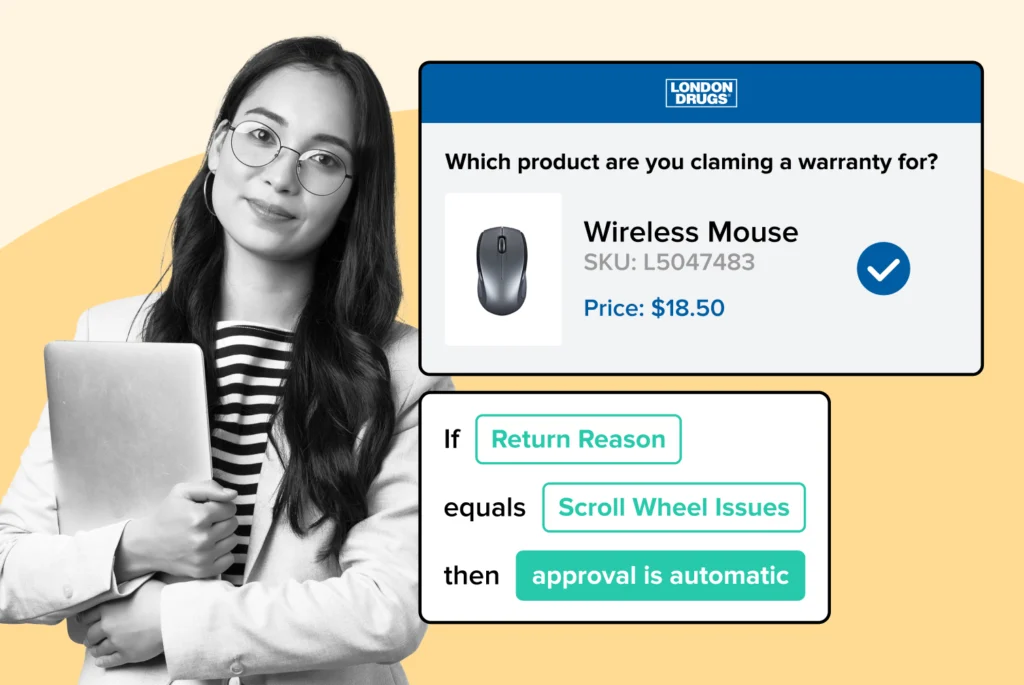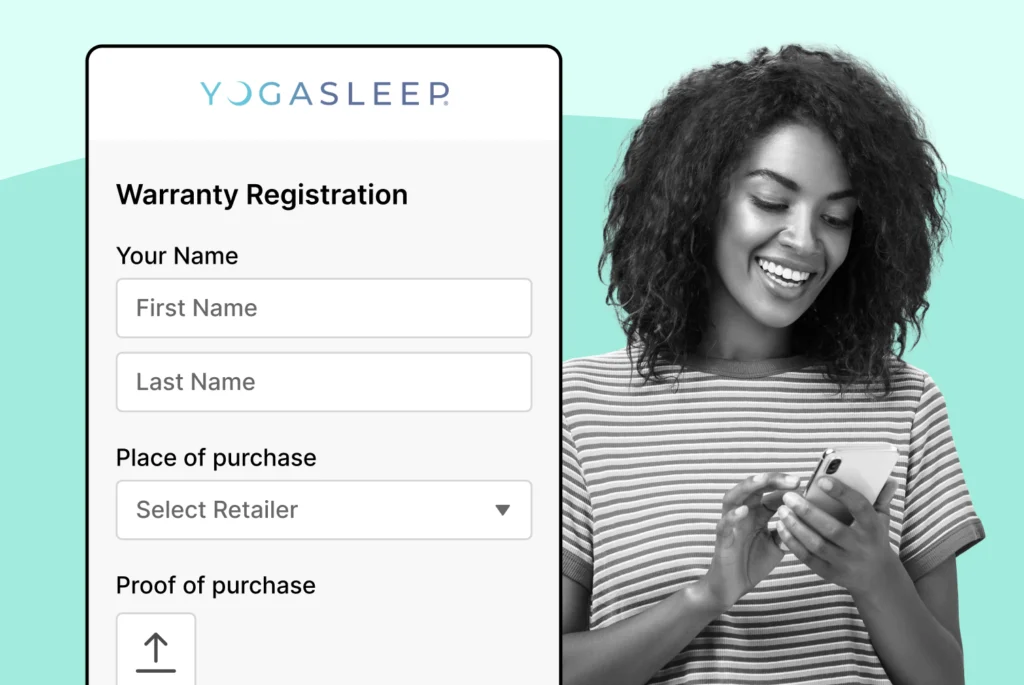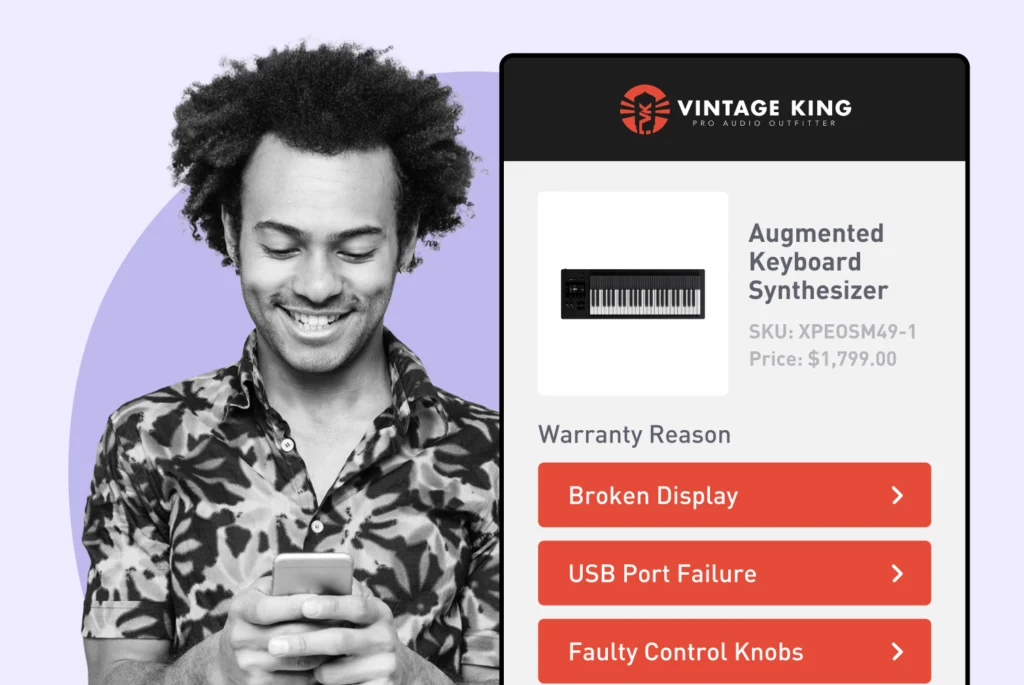
Streamline Your Business with Effective Shipping Insurance Integration
Discover how effective shipping insurance integration can enhance your business efficiency and protect your assets. Read the article for practical insights.
Shipping, Tracking & Notifications
Boost customer experience and reduce support tickets
Realtime order and shipment tracking
Proactive order and shipping notifications
AI-Enhanced Discounted Labels
Predictive pre-purchase estimated delivery dates
Self-Serivce branded order tracking
Effortless experience delivered
Identify and Resolve Order Issues
Realtime order and shipment tracking
Make returns profitable and delight customers
Flexibility to define any return destinations & conditions
Simplify returns for your customers and team
Incentivize exchanges over returns
Returns management made easy for your team
Returns management made easy for your team
Easy claims and smart upsells
Understand why your customers are returning
In-Store & Curbside Pickup
Unify the online and the in-store experience
Hassle-free pickup experience for customers
In-Store dashboard to keep operations streamlined
In-Store and Online orders unified
Drive foot-traffic to your stores
Shipping, Tracking & Notifications
Boost customer experience and reduce support tickets
Realtime order and shipment tracking
Proactive order and shipping notifications
AI-Enhanced Discounted Labels
Predictive pre-purchase estimated delivery dates
Self-Serivce branded order tracking
Effortless experience delivered
Identify and Resolve Order Issues
Realtime order and shipment tracking
Make returns profitable and delight customers
Flexibility to define any return destinations & conditions
Simplify returns for your customers and team
Incentivize exchanges over returns
Returns management made easy for your team
Returns management made easy for your team
Understand why your customers are returning
In-Store & Curbside Pickup
Unify the online and the in-store experience
Hassle-free pickup experience for customers
In-Store Dashboard to keep operations streamlined
In-Store and Online orders unified
Drive foot-traffic to your stores
Boost customer experience and reduce support tickets
Realtime order and shipment tracking
Proactive order and shipping notifications
AI-Enhanced Discounted Labels
Predictive pre-purchase estimated delivery dates
Self-Serivce branded order tracking
Effortless experience delivered
Make returns profitable and delight customers
Flexibility to define any return destinations & conditions
Simplify returns for your customers and team
Incentivize exchanges over returns
Returns management made easy for your team
Equip your team for precise return checks.
Easy claims and smart upsells
Understand why your customers are returning
Unify the online and the in-store experience
Hassle-free pickup experience for customers
In-Store Dashboard to keep operations streamlined
In-Store and Online orders unified
Drive foot-traffic to your stores
Find the answer to all your questions
Take a step by step trip through our functionality to see how we can improve your ecommerce processes.
Explore the most comon questions about WeSupply
Calculate the ROI that WeSupply can bring you
Read actionable articles on how to optimize your post-purchase experience and decrease support tickets
Get inspired by stories of how our customers implemented an effortless post-purchase experience
Wondering if WeSupply is a good fit for you? Read through our use cases to see how we can help you increase conversion & improve CX!
A Deep Dive into Top Companies' Order Tracking & Returns Strategy
Find the answer to all your questions
Explore the most comon questions about WeSupply
Calculate the ROI that WeSupply can bring you
Request a no strings attached review of your current shopping experience and missed conversion opportunities
Take a step by step trip through our functionality to see how we can improve your ecommerce processes.
Read actionable articles on how to optimize your post-purchase experience and decrease support tickets
Get inspired by stories of how our customers implemented an effortless post-purchase experience
A Deep Dive into Top Companies' Order Tracking & Returns Strategy
Wondering if WeSupply is a good fit for you? Read through our use cases to see how we can help you increase conversion & improve CX!

In today’s fast-paced world of ecommerce and global shipping, customers expect more than just fast deliveries—they expect transparency, reliability, and timely updates. But even with the most optimized supply chains, shipment exceptions are inevitable. A shipment exception occurs when a package is delayed, rerouted, or halted for any number of reasons, such as incorrect addresses, adverse weather conditions, customs holdups, or failed delivery attempts. When a shipment encounters an exception, it can disrupt the supply chain and delivery process, leading to delays, increased costs, and inventory issues. These disruptions can be frustrating not only for your customers but for your logistics and customer service teams as well, so addressing shipment exceptions benefits businesses and customers alike.
The good news is that managing shipment exceptions effectively—especially through real-time customer communication—can transform a potentially negative experience into an opportunity to build trust. Effective exception management is crucial for maintaining customer trust. By investing in proactive processes, advanced tracking tools, and customer-centric communication, your business can stay ahead of disruptions and maintain customer loyalty.
Shipment exceptions are any unexpected events that interrupt the standard delivery process. This broad category includes issues such as weather delays, customs holds, incorrect shipping information, lost or damaged items, and carrier-related problems. These are some of the most common causes of delivery exceptions, which can lead to disruptions in the shipping process. A specific subset of shipment exceptions is delivery exceptions, which occur during the final stage of shipping—usually when the package is already with the carrier and out for delivery. A delivery exception means a delay in package delivery caused by various issues such as carrier problems, incorrect labeling, or weather conditions.
Delivery exceptions might include scenarios like the recipient being unavailable, an inaccessible delivery address, a package being returned to the sender, or other common delivery exception scenarios such as missed deliveries or damaged packages. Common delivery exceptions often involve carrier problems, incorrect labeling, or external factors like weather. Regardless of the cause, these exceptions often result in delivery delays or failed deliveries, leading to increased customer service inquiries, added operational costs, and reduced customer satisfaction.
Understanding these distinctions is the first step in creating a streamlined, proactive strategy for managing disruptions and setting customer expectations.
To effectively manage exceptions, it’s essential to understand where they occur within the delivery lifecycle. From the moment a customer places an order, several stages unfold: order processing, packaging, shipping packages, carrier pickup, in-transit movement, and final-mile delivery.
Each stage carries its own risks. Errors in the recipient’s address during checkout may go unnoticed until the last mile, making accurate address entry critical to prevent exceptions. Packaging mishaps might not be discovered until a damaged parcel reaches its destination, and issues with the shipping label—such as damaged or missing labels—can cause delivery exceptions or delays. Proper handling of shipping packages is essential to avoid these problems. Carrier mishandling can disrupt packages en route; the delivery driver may face challenges like access issues or recipient unavailability, which can lead to exceptions. Customs delays can stall international shipments indefinitely.
During carrier pickup and in-transit movement, the shipping company plays a key role in managing missed deliveries, re-delivery options, and parcel return procedures. Disruptions in the delivery route, such as traffic, weather, or accidents, can also cause significant delays or lost orders.
By mapping out each touchpoint in your delivery flow and identifying where exceptions are most likely to occur, you can take targeted steps to reinforce those areas with stronger processes and tools.
Prevention is always better than cure. Reducing the likelihood of shipment exceptions begins at the order stage. Taking proactive measures to minimize delivery exceptions is essential for maintaining customer satisfaction and smooth logistics. Address verification tools at checkout ensure that customers input valid, complete addresses. These tools can catch missing apartment numbers, incorrect zip codes, and even street name mismatches in real time.
Next, attention to labeling and packaging is key. Shipping labels should be printed clearly and affixed securely to prevent scanning issues or loss in transit. Avoid placing tape over barcodes and double-check that package weight and dimensions match what’s listed on the label. Proper labeling and packaging help prevent delivery exceptions by ensuring shipments are processed accurately and efficiently.
Planning around known disruptions can further reduce exceptions. Be proactive about peak shopping seasons, national holidays (especially for international shipping), and seasonal weather hazards by implementing strategies to avoid delivery exceptions caused by these factors. If you sell regulated goods like hazardous materials, ensure all compliance documentation and labeling is accurate.
Finally, diversify your carrier partnerships. Working with multiple reliable carriers provides flexibility in case one experiences service issues. Carrier diversification also helps you select the best shipping partner for specific delivery regions, speeds, and package types, contributing to on time delivery and timely delivery.
Optimizing shipping operations and supply chain operations can further reduce the risk of exceptions and enhance overall delivery performance.
Real-time tracking isn’t just a nice-to-have—it’s essential for identifying potential exceptions before they escalate. It also helps manage delivery exceptions efficiently by providing instant visibility into disruptions as they occur. By implementing robust delivery management software (DMS) that integrates with multiple carriers, businesses can view the status of every shipment on a centralized dashboard.
Some advanced systems incorporate AI-powered analytics that monitor trends, identify red flags, and even predict future issues based on traffic, weather patterns, or historical carrier performance. These tools assist in handling delivery exceptions and managing exceptions proactively, allowing operations teams to step in before a package becomes officially “delayed” or “lost.”
Setting up automated alerts is another essential feature. These alerts can notify your team (and your customer) the moment a status changes or when a delivery exception is detected, enabling immediate response. Predictive alerts also help identify unforeseen events and unforeseen circumstances—such as severe weather, natural disasters, or traffic accidents—that could disrupt deliveries, allowing for faster intervention.
Detecting an exception early makes all the difference in how quickly it can be resolved. Your operations or customer service teams should regularly review tracking data to catch any anomalies. Exceptions are typically flagged by carriers, but relying solely on their notifications can lead to missed updates. Understanding the delivery exception process is essential for efficient resolution and maintaining customer satisfaction.
Categorizing these exceptions allows for more efficient handling. A shipping exception can occur at any stage of the delivery process, whether during pickup, transit, or final delivery. For example, an incorrect address might require contacting the customer to confirm new details. A customs hold might require additional documentation. By understanding what type of exception you’re dealing with, your team can take the most effective next step toward resolution.
When a shipment encounters an issue, it should be flagged immediately to minimize delays and operational disruptions. It’s also crucial to designate internal ownership of exception cases. Assign dedicated roles or escalation processes so that issues don’t fall through the cracks. In many cases, you may need to contact the carrier to clarify the cause of the exception and resolve the issue promptly.
Communication is one of the most powerful tools in your shipment exception toolkit. When something goes wrong, customers want to know two things: what happened and what you’re doing about it. Effective communication during exceptions is crucial for a positive customer experience.
Notify customers immediately once an exception is detected. Use the communication channels they prefer—whether that’s SMS, email, or push notifications. Keep your message concise, free of technical jargon, and honest. Instead of “Delivery exception due to failed scan,” say, “There was a delay while your package was being sorted by our delivery partner. We’re on it!”
Providing an updated delivery estimate and explaining what the next steps are can go a long way. If customer input is needed (like correcting an address), make the required action simple and clearly outlined. Poor communication can lead to dissatisfied customers, so timely and clear updates are essential.
Even if there’s no major update, sending regular status check-ins reassures the customer that they haven’t been forgotten. This level of transparency builds trust, even in the face of disruption. Online shoppers expect real-time updates to avoid frustration and maintain confidence in your service.
Empowering your customers with access to information reduces support volume and enhances satisfaction. Branded tracking pages allow customers to view real-time updates without having to email or call your team. These portals can include shipment status, estimated delivery dates, and explanations of any exceptions.
Many ecommerce platforms also support self-service functions such as address correction, delivery scheduling, or initiating a reshipment request. Integrating these capabilities into your customer service workflows gives customers control while lightening your team’s load.
Automation tools like chatbots and email sequences can also play a role. For simple exceptions, such as “recipient not home,” a bot could offer rescheduling options or direct the customer to a nearby pickup location.
Once an exception is identified and communicated, resolving it swiftly is the next critical step. Start by contacting the shipping carrier to clarify the cause and determine what actions are needed. It’s important to understand the procedures and limitations of different shipping carriers, as each may handle exceptions differently. For example, USPS delivery exceptions often occur due to federal holidays or incorrect recipient addresses, which can trigger exception notices during package tracking. DHL delivery exceptions may arise from customs issues, documentation problems, or compliance rules, requiring flexibility and prompt action to maintain customer satisfaction. Many issues, like wrong addresses or missed deliveries, can be quickly corrected if handled early.
Your internal teams should be trained to troubleshoot the most common scenarios: resending a shipment, issuing a refund, or rerouting to a new address. Have standard operating procedures (SOPs) in place for each category of issue so that responses are consistent and timely.
Offering goodwill gestures like discounts, expedited reshipping, or store credit can help turn a negative experience into a positive one. Most importantly, keep the customer informed throughout the resolution process until the issue is fully resolved.
Prevention doesn’t end with one fix. Businesses should continuously monitor delivery operations and pinpoint recurring issues. Recurring exceptions can disrupt the supply chain and lead to inventory issues. This might involve re-training warehouse staff on packaging standards, setting up better label-printing procedures, or flagging high-risk addresses or regions.
Weather and traffic updates can be integrated into delivery planning tools to help adjust delivery schedules proactively. In peak seasons, temporarily switching carriers or upgrading service levels can help mitigate delays.
Make sure that your shipping and fulfillment teams are aligned with your customer service department. When delivery exceptions occur, having a cross-functional feedback loop ensures future improvements are identified and acted upon.
Modern logistics requires modern tools. Automation and integration are essential for managing exception cases at scale. Using APIs to sync data across your ecommerce platform, shipping software, and customer communication systems allows for seamless real-time updates.
Implement automated workflows that trigger alerts and responses based on specific exception types. For example, if a shipment is marked as “undeliverable,” your system can automatically notify the customer, flag the support team, and initiate a return or reshipment process.
Consider working with third-party logistics (3PL) providers who specialize in end-to-end tracking, exception handling, and carrier management. Many offer dashboards and analytics to help you spot inefficiencies in your delivery pipeline.
To make meaningful improvements, you need to track the right metrics. Key performance indicators (KPIs) like exception rate, average resolution time, and delivery success rate give insight into how well your team handles disruptions.
Use exception logs to identify patterns. Are most issues happening in a specific region? Are certain carriers more prone to delays? Are address errors coming from a particular sales channel?
Analyzing this data allows you to make data-driven decisions about carrier selection, fulfillment procedures, and communication strategies. Over time, this leads to fewer exceptions and higher customer satisfaction.
Shipment exception management isn’t a one-time fix—it’s an ongoing commitment. Establish regular review processes to analyze root causes and implement preventive changes. Hold post-mortems after peak seasons or large-scale disruptions to identify weak links in your process.
Use insights from customer feedback, performance metrics, and support ticket trends to update SOPs and training materials. Keep your systems and tools updated to ensure compatibility with carrier platforms and customer service workflows.
Encourage a culture of accountability and adaptability across your operations, customer service, and logistics teams. Continuous improvement ensures that your business becomes more resilient with every delivery cycle.
Once the dust settles, don’t stop communicating. Follow up with customers after the issue is resolved to ensure they’re satisfied with the outcome. This simple step shows that your business cares and values their experience.
A personalized email or message thanking them for their patience, possibly paired with a discount on their next purchase, can help rebuild trust. Gathering feedback also offers an opportunity to spot any lingering dissatisfaction or process gaps.
Following through after resolution reinforces a strong customer relationship and can turn one-time buyers into long-term loyalists.
Eliminate shipping anxiety
Book a quick call with our experts to see how WeSupply can help you fulfill customer demands and gain long-term trust by clearly addressing order arrival times and keeping them.
There are bound to be shipping issues, such as delays, lost packages, or undeliverable shipments — but how you respond to handle them will either make or break their trust. That’s where WeSupply comes in. With Shipment Tracking and Exception Management tools, you can take control of your shipping disruptions and keep your customers informed at every point in real-time—transforming a poor experience into a brand-building opportunity.
With WeSupply’s Real-Time Journey Dashboard, you have full insight over each order and shipment, automated messaging for customers, that doesn’t burden your support team down. From a single lost item to split shipments from various drop shippers, WeSupply enables you to automate and simplify these processes so that you can cut down on WISMO tickets and keep your customers happy.
Key WeSupply Features for Shipment Exception Management:
✅ Delayed Shipment Alerts – Spot delays early and notify customers proactively
✅ Stalled Shipment Detection – Identify and act on packages stuck in transit
✅ Lost or Stolen Package Claims – Let customers self-report issues via branded tracking pages
✅ Lost or Stolen Package Claims – Let customers self-report issues via branded tracking pages
✅ Multi-Shipment Support – Track split shipments and communicate item-level updates
✅ Customer Communication at Scale – Send personalized bulk updates automatically
✅ Automated SMS & Email Notifications – Keep customers informed with minimal manual work
✅ Custom Workflows – Build a tailored exception management process for your operations
✅ Estimated Delivery Dates – Set clear customer expectations and reduce shipping anxiety by embedding reliable arrival timelines into your logistics
✅ Self-Service Branded Order Tracking – Empower customers to check order status on a fully branded page instead of generic carrier links—customers check tracking 4.6x per order, so make every interaction count
🚀 Ready to take control of your shipping experience? Get started today or schedule a demo and see how easy it is to turn exceptions into opportunities with WeSupply.
Shipment exceptions are an inevitable part of ecommerce, but with the right approach, they can become powerful moments to strengthen customer relationships.
WeSupply empowers you to manage these challenges with real-time shipment visibility, proactive delay detection, and automated customer communication—so your team can step in before frustration takes hold. Features like estimated delivery dates reduce shipping anxiety, while branded order tracking puts customers in control of their post-purchase experience. Even when orders are split across multiple shipments or hit unexpected delays, WeSupply keeps everyone informed with customizable workflows, bulk notifications, and embedded tracking updates.
By resolving issues like undeliverable or lost packages quickly and transparently, you not only protect your margins—you build trust. Every exception becomes a chance to demonstrate reliability, elevate your customer experience, and streamline operations for long-term growth.
Combat inconvenience with proactivity & self service
Book a quick call with our experts to see how WeSupply can help you make returns easy for your customers with a beautiful, self-service solution that makes their experience easier while also providing new ways to lower costs and earn back revenue.
1. What is a shipment exception in ecommerce?
A shipment exception occurs when a package is delayed, rerouted, or halted due to issues like weather, incorrect addresses, or customs holds—disrupting the normal delivery process.
2. How can I reduce delivery exceptions in my online store?
Use address verification at checkout, improve labeling and packaging, plan around known disruptions, and diversify carriers to reduce exception risks.
3. Why is real-time shipment tracking important?
Real-time tracking helps detect delivery issues early, enables faster resolutions, and keeps customers informed—boosting satisfaction and reducing WISMO inquiries.
4. How should I communicate a shipment delay to customers?
Use clear, jargon-free messages via SMS or email, provide updated delivery timelines, and explain next steps to maintain transparency and trust.
5. How does WeSupply help manage shipping exceptions?
WeSupply offers real-time dashboards, delay alerts, and automated messaging to detect and resolve issues like lost, delayed, or undeliverable shipments quickly.
6. Can WeSupply notify customers about delivery issues automatically?
Yes. WeSupply sends automated SMS and email updates for stalled or delayed shipments, keeping customers informed without overwhelming your support team.
7. Does WeSupply support tracking for split shipments?
Absolutely. WeSupply’s multi-shipment support tracks each item individually and provides item-level updates, ensuring a smooth experience for customers receiving multiple packages.
8. Does WeSupply have an Official Shopify App?
Yes. WeSupply has an Official Shopify App. You can download it and start integrating with your Shopify Store.
9. Does WeSupply have an official Magento extension?
Yes, WeSupply has an official extension for Magento. The WeSupply x Magento integration allows for automating order tracking experiences, reducing customer inquiries, automating shipping email and SMS notifications, and providing a fully branded order tracking experience
10. Does WeSupply have an official BigCommerce App?
Yes, WeSupply has an official BigCommerce App. You can integrate WeSupply with your BigCommerce store to improve your post-purchase customer experience.
Learn How To Create Successful Post Purchase Email Campaigns
Build an effective post-purchase email flow that helps you increase customer satisfaction and drive revenue growth!

Discover how effective shipping insurance integration can enhance your business efficiency and protect your assets. Read the article for practical insights.

Discover effective strategies to manage your shipments with ease. Streamline your process and enhance your shipping efficiency!

Discover how effective warranty returns management can enhance customer loyalty and strengthen your brand. Read on to transform your return process!

Learn how to streamline warranty returns at scale with practical strategies for efficiency and effectiveness. Read the article for actionable insights.

Create an effective warranty return flow for fragile goods to minimize losses and enhance customer satisfaction. Discover practical steps in our article.

Discover effective strategies to combat warranty fraud and protect your business. Learn best practices for prevention and safeguard your assets. Read more!

Master the essentials of electronics warranty return management with our comprehensive guide. Streamline your process and reduce hassle. Read more now!

Learn effective strategies for offering self-service warranty returns that enhance customer satisfaction and streamline your process!

Discover how warranties can boost customer loyalty and drive repeat purchases in online stores. Learn effective strategies to enhance your sales. Read more!